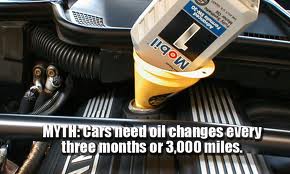You may not know it, but you might be spending way more on car maintenance than you have to. For years, we have all been told that there are car maintenance “rules” to go by, and if you don’t follow them, it’s going to be terrible for you car, both in the long and short-term. For some reason, these myths are automatically passed on from generation to generation (grandfather to grandson, father to daughter) and we never think to question them (considering the source, of course). However, today’s cars have changed and need much less maintenance than Grandpa’s car, and the old myths deserved to be challenged. Here are seven car maintenance myths unmasked that will save you time – and a whole lot of money. Click read more for the 7 myths you should know.
Myth #1: If you can swing it, always use premium gas. It’s much better for your car performance-wise and will make your car last longer.
Reality: Almost every car runs just fine on regular fuel; you simply don’t have to use premium. It won’t make your car perform better, you won’t get better gas mileage, and it has nothing to do with making your car last longer. Premium is mainly designed for high compression engines, such as sports cars and high-end luxury cars, and even then, it’s mainly to stop the engine from “knocking.” Premium gas can run 15 to 20 cents higher per gallon, but you can use the “cheap gas” and save hundreds of dollars a year, and you’ll do just fine.
Myth #2: If the brake fluid is low, topping it off will fix the problem.
Reality: Brake fluid is there to tell you how your brake pads are holding up. If your fluid level drops below the low mark on the brake reservoir, then it’s either that your brake fluid is leaking or your brakes are worn out. Whichever it is, you need to get your brakes serviced right away. Bottom line: if your brake fluid is low and you top it off, you are only masking the problem.
Myth #3: When it’s cold outside, you need to sit and idle a bit to warm the car up.
Reality: You are just wasting gas, believe it or not. It may seem that warming up the engine to its normal temperature while sitting is a good idea, but you’re really just putting out exhaust fumes. Go ahead and drive it gently for five to ten minutes until it’s warmed up; don’t just idle and wait to leave.
Myth #4: You have to change your oil every 3,000 miles no matter what.
Reality: You do not have to change your oil every 3,000 miles, or even every three months. Today’s cars are designed more efficiently so that you can go longer between oil changes. You can still do it if you feel like you should, but it’s just going to be more expensive. Check your owner’s manual. If it says that you can go 10,000 miles, then change your oil around 10,000 miles. A lot of cars call for oil changes at 7,500 miles. Two or three extra oil changes a year can add up to money that you could be using for something else, especially when you consider the life of the car.
Myth #5: If you put oversized/wider snow tires on your car, you will have better car traction.
Reality: Nope. It’s just the opposite. If you have wider tires, they never really dig into the road enough to gain traction because of their wider-edged tread. Narrow tires are better, especially in deep snow. The tire has a narrow-edged tread that will push through the snow faster than a wider tire.
Myth #6: Regular car maintenance must be done by your car dealership to keep your warranty valid.
Reality: If you do the same maintenance tasks that are written in your owner’s manual on the recommended schedule, then you can go to any auto-repair shop and have them done. Keep all of your records and receipts in case you have to go in to the dealer for a repair and have a problem with warranty conflict.
Myth #7: Run the gas tank as low as you want to; it doesn’t hurt anything.
Reality: The fuel pump in a modern car is the high-pressure device that is used to supply fuel to the fuel injection system or carburetor (depending on the kind of car you have). The fuel pump is actually cooled by the gasoline itself, and if you run your tank too low, the pump overheats. If you run it out of gas completely, then the dirt that has settled to the bottom of the tank can be sucked into the pump and sent through the fuel system, where it clogs little places here and there along the way. If you get down to a quarter of a tank, fill it up. Your car will run a lot better and you won’t have to spend money getting a new fuel pump.
Car maintenance rules have changed throughout the decades and will continue to do so as long as car manufacturers continue to make cars more efficient and safe. Bottom line: don’t waste your money on old car maintenance advice; save your money (and your piece of mind) on the realities of modern car efficiency, both now and in the future.
This post was written and contributed by Edson Farnell. Edson’s automotive journey began when he was working at an auto parts warehouse. He writes on a variety of topics such as BMW parts. Many of Edson’s friends refer to him as the Auto Parts Geek.


